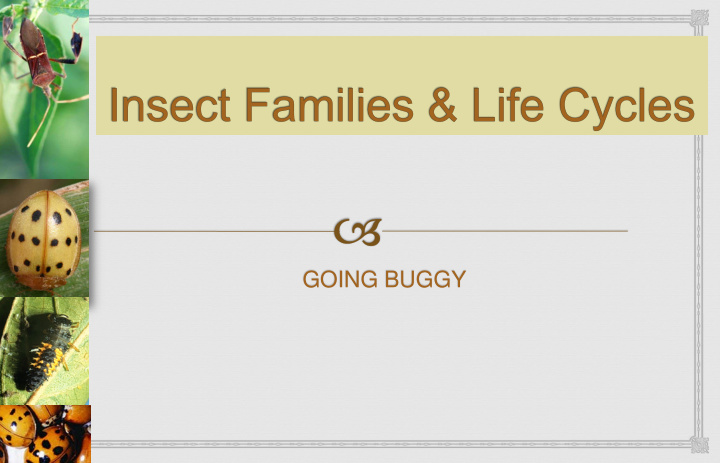



GOING BUGGY
Fun Facts Insects have been around for at least 350 million years Over 900,000 described species U.S. has about 91,000 described species Less than 1% of these are considered pests Four largest insect orders: beetles (Coleoptera), flies (Diptera), ants (Hymenoptera), moths (Lepidoptera) In the typical backyard there are >1000 insects at any given time
Fun Facts What do you know about insects?
CLASSIFICATION OF ANIMALS (On the front slide, facing the students is a chart showing the basic classification of animals.) Tell the students to notice the circle around INSECTS and that Arachnids are not in that group. Arachnids and Insects though are in Arthropods. More about Arthropods and Insects on the next slide.
Insects and Their Relatives (Arthropods) Both Insects & Arachnids: have exoskeletons, segmented bodies and jointed appendages exoskeleton must be shed periodically Insects: Ask the students to point to the Arachnids and then point to the Insects or vis-a-versa. Three body regions (head, thorax and abdomen) Six legs Arachnids (spiders, mites, ticks): Two body regions (head and abdomen) Adults have eight legs
Arachnids vs. Insects
Complete Metamorphosis Four distinct growing stages: Egg- immobile Larvae- feeding Pupa- immobile Adult- reproduction Butterflies, moths, flies, beetles, wasps, and bees. See Lucite of life cycle of housefly, figures of ant and ladybug life cycles
Complete Metamorphosis
Incomplete Metamorphosis Young resemble adults but without wings No Pupal stage Egg → nymph → adult True Bugs, dragonflies, grasshoppers, termites See Lucite of life cycle of grasshopper
Incomplete Metamorphosis
Keying or Classifying Insects: Needed to study the thousands of insect species. Use distinguishing These are: characteristics of the Mouthparts orders to key or classify Legs Many more ways to key Wings or classify insects but these are some of the easiest characteristics you can use.
Keying or Classifying Insects
Insect Mouthparts Chewing – bees and some wasps Piercing-sucking – mosquitos, fleas, horseflies, most true bugs, leafhoppers Siphoning – butterflies and moths Sponging – houseflies, Use the laminated sheet (in the bin) to quiz the students on the stableflies mouthparts by asking them to match the insect with its mouthpart.
Insect Mouthparts
Types of Legs
Use the laminated sheet (in the bin) to quiz the students on the mouthparts by asking them to match the insect with its mouthpart. Types of Legs • Cursorial – running • Raptorial – predaceous • Saltatorial – jumping • Natatorial - swimming
Wings • Number of wings varies by species - 2 pairs - 1 pair on the mesothorax - absent • Functions - locomotion - protection - camaflouge
Types of Wings • Elytra - hardened, front wings that serve as protective covers for membranous hind wings • Hemelytra - front wings that are leathery or parchment- like at the base and membranous near the tip • Halteres - small, club-like hind wings that serve as gyroscopic stabilizers during flight • Tegmina - front wings that are completely leathery or parchment-like in texture
Types of Wings HE ME L YTRA TE GMINA
Recommend
More recommend